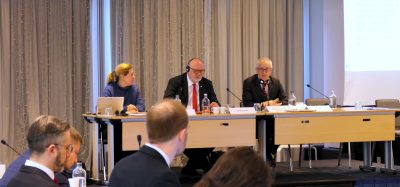New trains, new routes and new services – Eurostar’s vision for the future
Posted: 27 November 2012 | | No comments yet
Since Eurostar’s maiden voyage in 1994, we have carried over 130 million passengers across the Channel. Today, eight out of 10 passengers travelling between London and Paris and Brussels choose to do so by high-speed rail on a Eurostar service, with almost 10 million people travelling with us last year alone.
When I think back to the moment the first passenger service pulled out of London Waterloo 18 years ago, I cannot help but be struck by the travel revolution that has taken place during that time. In 1994, we could never have foreseen that by 2012 London would be France’s sixth largest city, with a regular stream of commuters enjoying the high-speed rail link between the UK and the Continent.
We are entering a very exciting period for high-speed European rail – a rail renaissance – as the deregulation of the market brings with it new routes, new partnerships and new services across the network. We expect to see an exciting period of growth and innovation over the coming years, just as has been seen in other newly liberalised markets like energy and telecoms. The ultimate winners will be the passengers and they can expect to experience a raft of innovations and better choice.
Since Eurostar’s maiden voyage in 1994, we have carried over 130 million passengers across the Channel. Today, eight out of 10 passengers travelling between London and Paris and Brussels choose to do so by high-speed rail on a Eurostar service, with almost 10 million people travelling with us last year alone. When I think back to the moment the first passenger service pulled out of London Waterloo 18 years ago, I cannot help but be struck by the travel revolution that has taken place during that time. In 1994, we could never have foreseen that by 2012 London would be France’s sixth largest city, with a regular stream of commuters enjoying the high-speed rail link between the UK and the Continent. We are entering a very exciting period for high-speed European rail – a rail renaissance – as the deregulation of the market brings with it new routes, new partnerships and new services across the network. We expect to see an exciting period of growth and innovation over the coming years, just as has been seen in other newly liberalised markets like energy and telecoms. The ultimate winners will be the passengers and they can expect to experience a raft of innovations and better choice.
Since Eurostar’s maiden voyage in 1994, we have carried over 130 million passengers across the Channel. Today, eight out of 10 passengers travelling between London and Paris and Brussels choose to do so by high-speed rail on a Eurostar service, with almost 10 million people travelling with us last year alone.
When I think back to the moment the first passenger service pulled out of London Waterloo 18 years ago, I cannot help but be struck by the travel revolution that has taken place during that time. In 1994, we could never have foreseen that by 2012 London would be France’s sixth largest city, with a regular stream of commuters enjoying the high-speed rail link between the UK and the Continent.
We are entering a very exciting period for high-speed European rail – a rail renaissance – as the deregulation of the market brings with it new routes, new partnerships and new services across the network. We expect to see an exciting period of growth and innovation over the coming years, just as has been seen in other newly liberalised markets like energy and telecoms. The ultimate winners will be the passengers and they can expect to experience a raft of innovations and better choice.
At Eurostar, the transformation of our business from a partnership to a single, unified corporate entity in 2009 has put us in a strong position to manage our business more efficiently, better serve our customers and seize the new opportunities that deregulation of the market will bring.
A £700 million investment in our fleet
Central to our plans to capitalise on new opportunities is our £700 million programme of investment in our rolling stock. This includes the complete overhaul and redesign of the existing fleet of Eurostar trains, alongside purchasing 10 new trainsets from Siemens. These changes will ensure we can deliver the best possible service to our passengers as we expand our operations and travel directly further afield.
The new e320 trains, which will be in commercial service by 2015, will allow us to be more competitive. They are the same length as our existing fleet but come with 900 seats – 20% more capacity than we are currently able to offer. The 16-car, 400m-long trainsets have a top speed of 320km/h and are ‘interoperable’, which means they have the capability to run across the European highspeed rail network.
As Siemens progresses with the manufacturing of the new sets, our own internal preparation programme is underway to ensure the business is ready to welcome their arrival. With distributed power and roof-mounted equipment, the e320s’ maintenance requirements differ to our existing fleet. So, as well as training all of our maintenance staff, train drivers, train managers and on-board staff to operate and maintain the new sets, we are modifying our state-of-the-art depot, Temple Mills, to accommodate them.
On-board innovation
At the very heart of the investment programme are our customers. We continue to push the boundaries of rail travel to offer them the best possible travel experience.
For example, the new fleet programme has acted as a springboard for a renewed approach to the digital experience we provide to our passengers. As well as a new sleek interior designed by the world-famous Italian design house, Pininfarina, every Eurostar train will be equipped with advanced Wi-Fi connectivity and on-board ‘info-tainment’. Our passengers will be able to enjoy pre-loaded entertainment on their own devices via a secure wireless LAN and access real-time travel and destination information, video-on-demand, music and news-feeds.
In addition, Eurostar customers will soon reap the benefits of significant investment in our website and booking processes as a new look eurostar.com which is quicker and easier to use launches next year.
Connecting destinations across Europe
Across Europe we are starting to see the early signs of consolidation in the marketplace with several operators establishing alliances and partnerships. Our research shows that there are currently 20 million people taking short haul flights between the UK and locations in Europe that are easily accessible by the expanding European high-speed rail network and this presents a significant business opportunity.
In the UK, for travel beyond London to cities such as Manchester and Cambridge, Eurostar already has a number of partnerships in place with other train operating companies and we are now developing the same kinds of deals on the Continent.
Working with these partners we can offer customers new destinations across Europe. In 2012, we launched new services from London to Amsterdam and London to Switzerland, working alongside Thalys and Lyria to open up new routes.
The Thalys partnership enables passengers to make ‘point to point’ bookings to Amsterdam, offering a single price and single point of contact.
Our new partnership with ‘TGV Lyria’, which launched in October 2012, allows ski and snowboarding enthusiasts to book travel from St Pancras International and Ashford International to the heart of the Swiss Alps and the Valais region. With an easy connection in Lille Europe on to a high-speed ‘TGV Lyria’ service, passengers will arrive into Aigle, Martigny, Visp and Brig stations for quick onward transfers to their ski resorts.
We have seen a strong consumer appetite for connecting rail travel – one in four of our passengers already connect by high-speed rail to an onward destination – and we will con – tinue to work with our high-speed rail partners across Europe to build awareness.
The deregulation of the market will give all of our customers more choice and importantly, it will encourage more travellers to consider high-speed rail in Europe. This evolution of the European travel market means that there will continue to be a significant shift towards faster, more sustainable high-speed rail transport in the coming years.
About the author
Nicolas Petrovic became CEO of Eurostar in April 2010. He joined as Director of Customer Services, London, in August 2003 before spending almost four years as Chief Operating Officer. Prior to his tenure at Eurostar, Nicolas worked for SNCF as the Secretary General for Direction Grandes Lignes and Operational General Manager for the Paris Saint-Lazare area. In addition to his extensive experience in the transport industry in both the UK and France, Nicolas gained an MBA from INSEAD in 2003.






